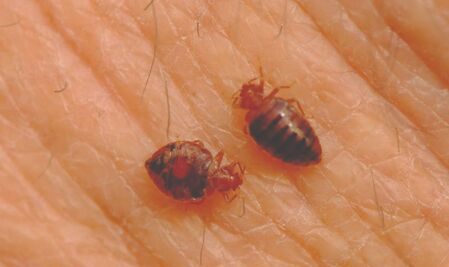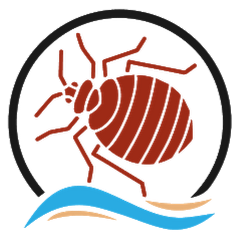DO You HAVE BED BUGS?
What Some Exterminators miss during a BEd Bug inspectioN
Written By: Virginia Beach Bed Bug Co., June 3, 2020

Summary: The most common reason exterminators MISS bed bugs during an in-home inspection is failure to remove the under box spring dust cloth.
(#2 was failure to inspect behind plastic box spring corners).
Also, many bed bug exterminators fail to actually speak to their client prior to the in-home inspection.
At Virginia Beach Bed Bug Co. the first phone consultation is always free and occurs prior to technician arrival where we can address all of your initial questions and concerns.
So, without further ado, we give you the golden rule when seeking a bed bug inspection:
Try Not To Panic.
But if you've already broken this rule, this page will help you deal by outlining a simple, methodical Bed Bug Battle Plan.
First, you need to confirm or deny the presence of bed bugs through inspection either by calling a professional or
DIY. Some places charge for an inspection, while others do not. It is important for each homeowner to ask why and what is included in their bed bug inspection.
Want to inspect for bed bugs yourself?
Contrary to popular belief, bed bugs are visible to the human eye. Even an untrained eye can spot some bed bug infests.
The problem with DIY inspections is knowing precisely where to look.
Here's a road map for a typical bed bug inspection...
An experienced bed bug professional will first bag the bedding (sheets, pillows, blankets, etc.) in garbage bags and tie tightly.
We find the majority of bed bugs in the box spring and the headboard. This makes sense since bed bugs always post up within about 5 feet of their human host.
How did you (allegedly) get bed bugs?
They most likely hitchiked in on someone's clothing or luggage. The hitchhiked person or carrier was most certainly an unknowing one.
Bed Bugs are very slight creatures that move at night to avoid detection. They copulate like mad. They locate their next meal with precision by detecting body heat (think dark thermal imaging colors) and CO2 (exhaled breath).
And so Once Upon a Bed Bug Time a singular female pregnant bed bug hitchhiked into your home, likely on clothing or luggage, and laid her eggs within 5 feet of where you sleep.
So here we are, inspecting for these little buggers and (hopefully) staying calm.
Ideally, you'll have a good flashlight and a (equally as good) buddy to assist you with the lifting.
The mattress is the first to be inspected and lifted. Pay special attention to the corners and seams.
The #1 Rule when inspecting for bed bugs: "Where There's Fecal, There's Fire."
Bed Bugs hide in plain sight. You are more likely to find fecal matter and other bed bug evidence first, before seeing an actual live bed bug.
The fecal matter of bed bugs look like tiny black dots and fresh fecal matter is "smearable," having a mascara like appearance and consistency. Basically, if you took a black fine-point Sharpie pen and made some little dots next to one another.
The bed bug skin shedding looks similar to what a snake's skin shedding would look like, only in a miniaturized, bed bug-size and form.
So you're looking for live bugs but will likely see bed bug fecal matter and their shedding before you spot an actual live bed bug. Don't forget, with bed bugs, you'll likely find the smoke before the fire so be on high alert for the fecal matter and skin shedding.
When inspecting the box spring, it's critical to tear off the black dust cloth stapled underneath. This is called "ticking," and it serves no practical purpose for your bed once it's in your home. But bed bugs love these things and use them as a canopy for hiding just underneath where the black cloth is stapled. We find them most prevalent at the corners. Also, be sure to take off and inspect those little plastic corners stapled on the box spring. (Don't overlook this!)
Remember, don't forget to rip off these plastic pieces rounding the bottom four corners of the box spring. This is also a prime hiding spot.
Next, the headboard. There are thousands of designs, but generally speaking, "porous" headboards, like IKEA , fabric, or leather wrapped designs are more difficult to inspect and you'll probably want to call in a bed bug pro for inspection. Solid wood with little ornamentation is quite easy to inspect using a proper flashlight.
Another critical area inside many bed frames: the horizontal wooden support planks that your bed rests on. Be sure to unscrew and inspect the screw holes, sides and bottom.
At Virginia Beach Bed Bug Co. we have the tools and experience to inspect and exterminate bed bugs affordably and with unmatched customer care. Our technicians are experienced, dedicated bed bug professionals who come from and trained in some of the nation's most active bed bug cities.
Many exterminators fail to actually speak to the client prior to arrival. Just give us a call.
We're here to help if you want guaranteed bed bug elimination that takes about a day, and we're available to you even after the job is done for both follow ups or additional questions.
UPDATE, MAY 2020: Our Technicians are COVID-19 Ready and Responsive.
(#2 was failure to inspect behind plastic box spring corners).
Also, many bed bug exterminators fail to actually speak to their client prior to the in-home inspection.
At Virginia Beach Bed Bug Co. the first phone consultation is always free and occurs prior to technician arrival where we can address all of your initial questions and concerns.
So, without further ado, we give you the golden rule when seeking a bed bug inspection:
Try Not To Panic.
But if you've already broken this rule, this page will help you deal by outlining a simple, methodical Bed Bug Battle Plan.
First, you need to confirm or deny the presence of bed bugs through inspection either by calling a professional or
DIY. Some places charge for an inspection, while others do not. It is important for each homeowner to ask why and what is included in their bed bug inspection.
Want to inspect for bed bugs yourself?
Contrary to popular belief, bed bugs are visible to the human eye. Even an untrained eye can spot some bed bug infests.
The problem with DIY inspections is knowing precisely where to look.
Here's a road map for a typical bed bug inspection...
An experienced bed bug professional will first bag the bedding (sheets, pillows, blankets, etc.) in garbage bags and tie tightly.
We find the majority of bed bugs in the box spring and the headboard. This makes sense since bed bugs always post up within about 5 feet of their human host.
How did you (allegedly) get bed bugs?
They most likely hitchiked in on someone's clothing or luggage. The hitchhiked person or carrier was most certainly an unknowing one.
Bed Bugs are very slight creatures that move at night to avoid detection. They copulate like mad. They locate their next meal with precision by detecting body heat (think dark thermal imaging colors) and CO2 (exhaled breath).
And so Once Upon a Bed Bug Time a singular female pregnant bed bug hitchhiked into your home, likely on clothing or luggage, and laid her eggs within 5 feet of where you sleep.
So here we are, inspecting for these little buggers and (hopefully) staying calm.
Ideally, you'll have a good flashlight and a (equally as good) buddy to assist you with the lifting.
The mattress is the first to be inspected and lifted. Pay special attention to the corners and seams.
The #1 Rule when inspecting for bed bugs: "Where There's Fecal, There's Fire."
Bed Bugs hide in plain sight. You are more likely to find fecal matter and other bed bug evidence first, before seeing an actual live bed bug.
The fecal matter of bed bugs look like tiny black dots and fresh fecal matter is "smearable," having a mascara like appearance and consistency. Basically, if you took a black fine-point Sharpie pen and made some little dots next to one another.
The bed bug skin shedding looks similar to what a snake's skin shedding would look like, only in a miniaturized, bed bug-size and form.
So you're looking for live bugs but will likely see bed bug fecal matter and their shedding before you spot an actual live bed bug. Don't forget, with bed bugs, you'll likely find the smoke before the fire so be on high alert for the fecal matter and skin shedding.
When inspecting the box spring, it's critical to tear off the black dust cloth stapled underneath. This is called "ticking," and it serves no practical purpose for your bed once it's in your home. But bed bugs love these things and use them as a canopy for hiding just underneath where the black cloth is stapled. We find them most prevalent at the corners. Also, be sure to take off and inspect those little plastic corners stapled on the box spring. (Don't overlook this!)
Remember, don't forget to rip off these plastic pieces rounding the bottom four corners of the box spring. This is also a prime hiding spot.
Next, the headboard. There are thousands of designs, but generally speaking, "porous" headboards, like IKEA , fabric, or leather wrapped designs are more difficult to inspect and you'll probably want to call in a bed bug pro for inspection. Solid wood with little ornamentation is quite easy to inspect using a proper flashlight.
Another critical area inside many bed frames: the horizontal wooden support planks that your bed rests on. Be sure to unscrew and inspect the screw holes, sides and bottom.
At Virginia Beach Bed Bug Co. we have the tools and experience to inspect and exterminate bed bugs affordably and with unmatched customer care. Our technicians are experienced, dedicated bed bug professionals who come from and trained in some of the nation's most active bed bug cities.
Many exterminators fail to actually speak to the client prior to arrival. Just give us a call.
We're here to help if you want guaranteed bed bug elimination that takes about a day, and we're available to you even after the job is done for both follow ups or additional questions.
UPDATE, MAY 2020: Our Technicians are COVID-19 Ready and Responsive.
